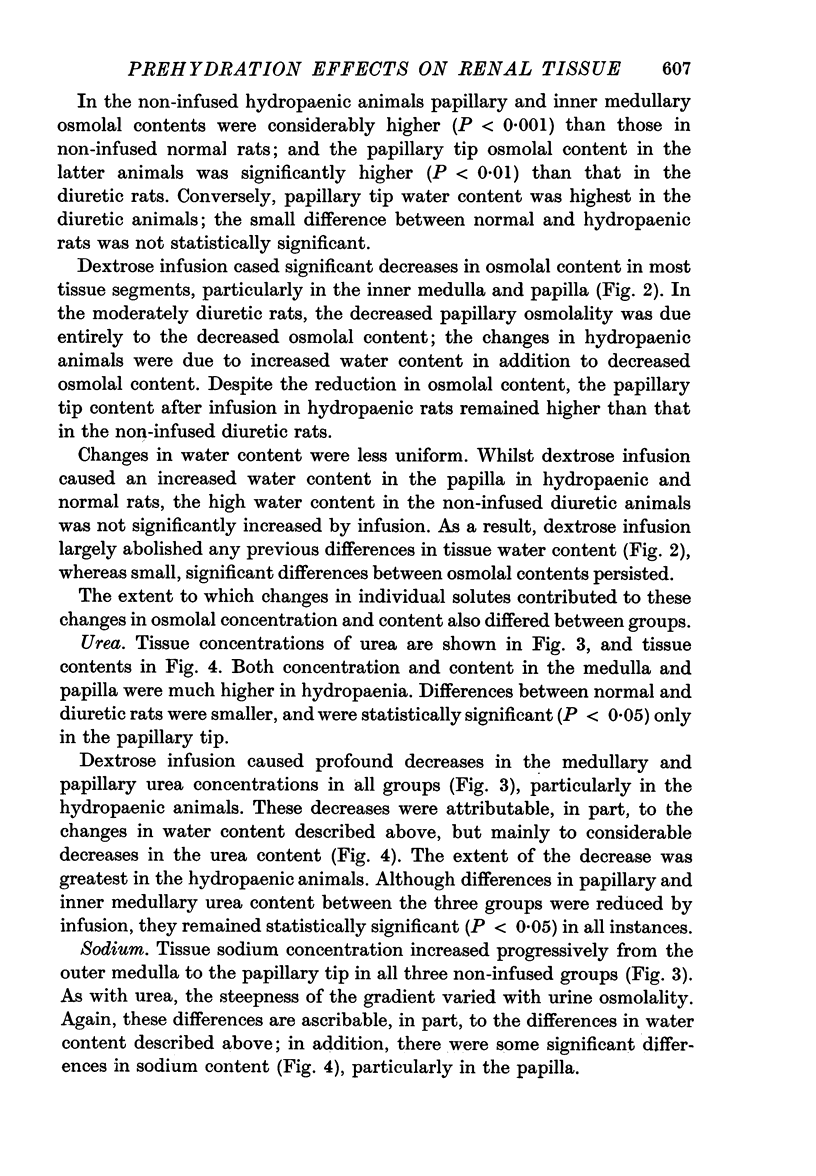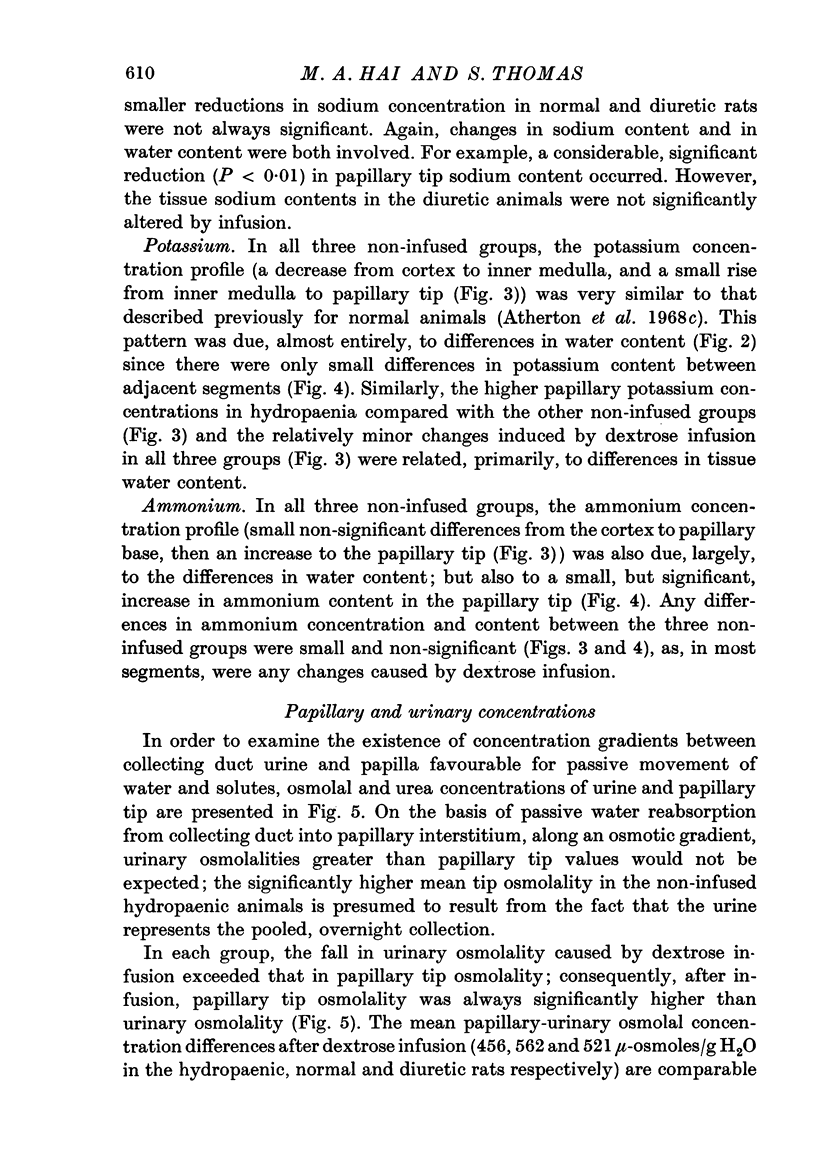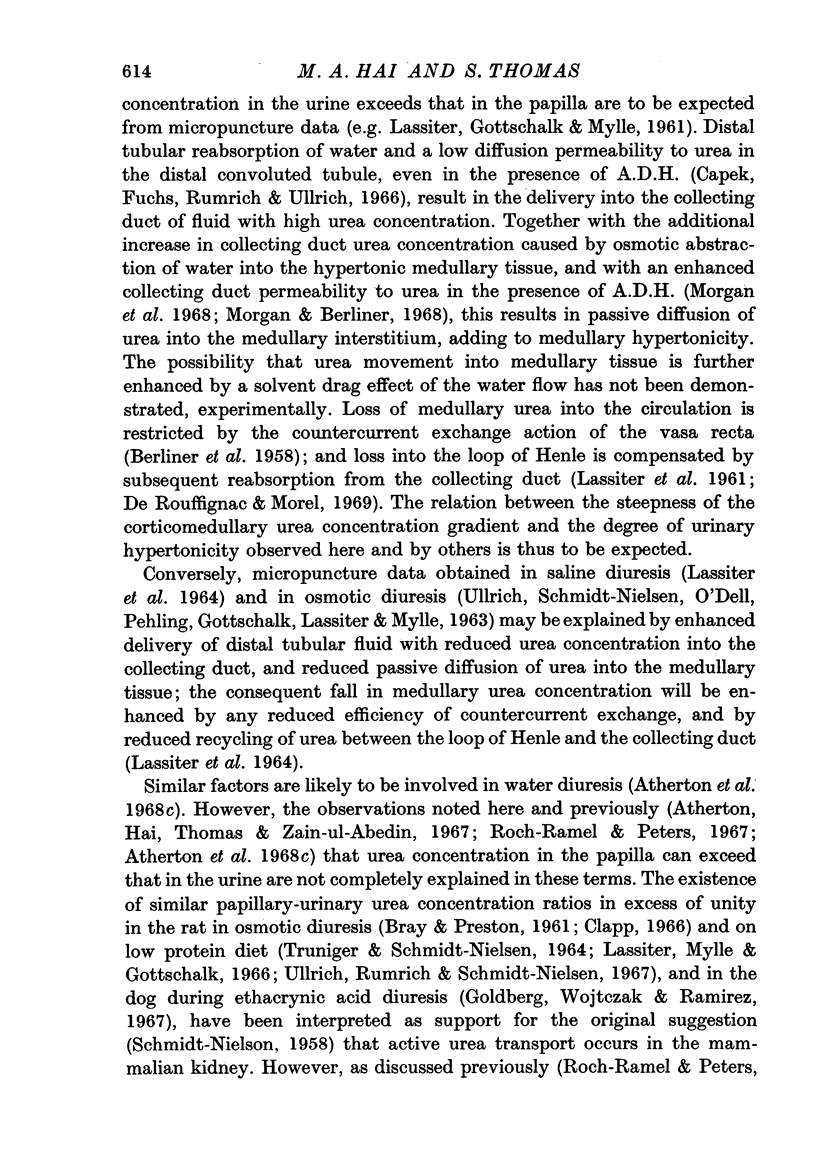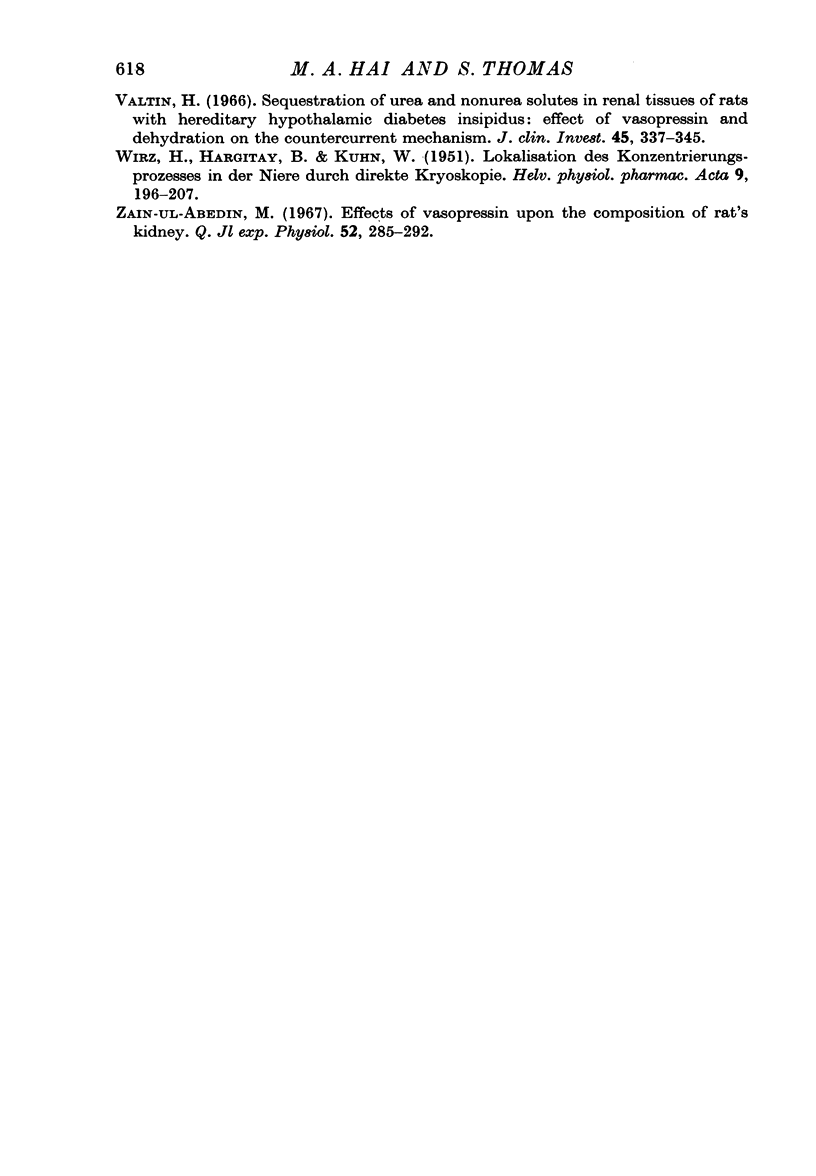Abstract
1. The composition of renal tissue was determined in rats before and immediately after intravenous infusion of dextrose (2·5 g/100 ml.) in amounts sufficient to administer a positive fluid load of 4% body weight over 2 hr. The rats were classified into three groups, according to the preinfusion urine osmolality: hydropaenia, normal and moderately diuretic (over 2400, 800-1500 and below 800 μ-osmoles/g H2O, respectively).
2. In non-infused rats, the steepness of the corticomedullary osmolal gradient varied, due to differences in both water and solute (sodium and urea) contents, and was related to urinary osmolality. Whereas differences in medullary and papillary solute contents occurred between all three groups, papillary water content was significantly higher only in the moderately diuretic animals.
3. Dextrose infusion caused the induction of water diuresis, the lowest urinary osmolalities being produced in the previously moderately diuretic animals.
4. Dextrose infusion caused a considerable reduction in the steepness of the corticomedullary osmolal gradient in all rats, particularly in the previously hydropaenic animals, due to changes in both solute (sodium and urea) and water contents. Whereas reductions in medullary and papillary solute contents occurred in all three groups, there was no further increase in papillary water content from the already high values seen in the noninfused diuretic animals.
5. Thus, dextrose infusion largely abolished any previous differences in tissue water content, whereas significant, though small, differences in osmolal (particularly urea) content persisted.
6. These data are discussed in terms of changes and differences in endogenous antidiuretic hormone (A.D.H.) release.
7. Changes in the magnitude and direction of the urinary-papillary urea concentration difference are discussed in terms of passive transport, with probable A.D.H.-induced changes in nephron urea permeability.
Full text
PDF



















Selected References
These references are in PubMed. This may not be the complete list of references from this article.
- Atherton J. C., Green R., Hai M. A. Evaluation of a method for weighing small tissue samples: investigations into freezing and evaporation. Pflugers Arch. 1969;309(3):203–211. doi: 10.1007/BF00586798. [DOI] [PubMed] [Google Scholar]
- Atherton J. C., Hai M. A., Thomas S. Effects of water diuresis and osmotic (mannitol) diuresis on urinary solute excretion by the conscious rat. J Physiol. 1968 Jul;197(2):395–410. doi: 10.1113/jphysiol.1968.sp008566. [DOI] [PMC free article] [PubMed] [Google Scholar]
- Atherton J. C., Hai M. A., Thomas S. The time course of changes in renal tissue composition during mannitol diuresis in the rat. J Physiol. 1968 Jul;197(2):411–428. doi: 10.1113/jphysiol.1968.sp008567. [DOI] [PMC free article] [PubMed] [Google Scholar]
- Atherton J. C., Hai M. A., Thomas S. The time course of changes in renal tissue composition duruig water diuresis in the rat. J Physiol. 1968 Jul;197(2):429–443. doi: 10.1113/jphysiol.1968.sp008568. [DOI] [PMC free article] [PubMed] [Google Scholar]
- BERLINER R. W., LEVINSKY N. G., DAVIDSON D. G., EDEN M. Dilution and concentration of the urine and the action of antidiuretic hormone. Am J Med. 1958 May;24(5):730–744. doi: 10.1016/0002-9343(58)90377-2. [DOI] [PubMed] [Google Scholar]
- BRAY G. A., PRESTON A. S. Effect of urea on urine concentration in the rat. J Clin Invest. 1961 Nov;40:1952–1960. doi: 10.1172/JCI104420. [DOI] [PMC free article] [PubMed] [Google Scholar]
- Berliner R. W., Bennett C. M. Concentration of urine in the mammalian kidney. Am J Med. 1967 May;42(5):777–789. doi: 10.1016/0002-9343(67)90095-2. [DOI] [PubMed] [Google Scholar]
- Capek K., Fuchs G., Rumrich G., Ullrich K. J. Harnstoffpermeabilität der corticalen Tubulusabschnitte von Ratten in Antidiurese und Wasserdiurese. Pflugers Arch Gesamte Physiol Menschen Tiere. 1966;290(3):237–249. [PubMed] [Google Scholar]
- Clapp J. R. Renal tubular reabsorption of urea in normal and protein-depleted rats. Am J Physiol. 1966 Jun;210(6):1304–1308. doi: 10.1152/ajplegacy.1966.210.6.1304. [DOI] [PubMed] [Google Scholar]
- Fourman J., Kennedy G. C. An effect of antidiuretic hormone on the flow of blood through the vasa recta of the rat kidney. J Endocrinol. 1966 Jun;35(2):173–176. doi: 10.1677/joe.0.0350173. [DOI] [PubMed] [Google Scholar]
- Goldberg M., Wojtczak A. M., Ramirez M. A. Uphill transport of urea in the dog kidney: effects of certain inhibitors. J Clin Invest. 1967 Mar;46(3):388–399. doi: 10.1172/JCI105540. [DOI] [PMC free article] [PubMed] [Google Scholar]
- Hai M. A., Thomas S. The time-course of changes in renal tissue composition during lysine vasopressin infusion in the rat. Pflugers Arch. 1969;310(4):297–317. doi: 10.1007/BF00587241. [DOI] [PubMed] [Google Scholar]
- Jamison R. L., Bennett C. M., Berliner R. W. Countercurrent multiplication by the thin loops of Henle. Am J Physiol. 1967 Feb;212(2):357–366. doi: 10.1152/ajplegacy.1967.212.2.357. [DOI] [PubMed] [Google Scholar]
- KOBINGER W. DIE WIRKUNG VON VASOPRESSIN AUF DIE KONZENTRATIONSGRADIENTEN VON NATRIUM UND HARNSTOFF IM NIERENGEWEBE BEI VERSCHIEDENEN DIURESEZUSTAENDEN. Naunyn Schmiedebergs Arch Exp Pathol Pharmakol. 1964 Mar 19;246:538–551. doi: 10.1007/BF00246307. [DOI] [PubMed] [Google Scholar]
- LASSITER W. E., GOTTSCHALK C. W., MYLLE M. Micropuncture study of net transtubular movement of water and urea in nondiuretic mammalian kidney. Am J Physiol. 1961 Jun;200:1139–1147. doi: 10.1152/ajplegacy.1961.200.6.1139. [DOI] [PubMed] [Google Scholar]
- LASSITER W. E., MYLLE M., GOTTSCHALK C. W. NET TRANSTUBULAR MOVEMENT OF WATER AND UREA IN SALINE DIURESIS. Am J Physiol. 1964 Apr;206:669–673. doi: 10.1152/ajplegacy.1964.206.4.669. [DOI] [PubMed] [Google Scholar]
- Lassiter W. E., Mylle M., Gottschalk C. W. Micropuncture study of urea transport in rat renal medulla. Am J Physiol. 1966 May;210(5):965–970. doi: 10.1152/ajplegacy.1966.210.5.965. [DOI] [PubMed] [Google Scholar]
- Leaf A. Membrane effects of antidiuretic hormone. Am J Med. 1967 May;42(5):745–756. doi: 10.1016/0002-9343(67)90092-7. [DOI] [PubMed] [Google Scholar]
- MOREL F. F., GUINNEBAULT M., AMIEL C. [Demonstration of a process of water exchange by counter-current in the deep regions of the hamster kidney]. Helv Physiol Pharmacol Acta. 1960;18:183–192. [PubMed] [Google Scholar]
- Martino J. A., Earley L. E. The effects of infusion of water on renal hemodynamics and the tubular reabsorption of sodium. J Clin Invest. 1967 Jul;46(7):1229–1238. doi: 10.1172/JCI105616. [DOI] [PMC free article] [PubMed] [Google Scholar]
- Morgan T., Berliner R. W. Permeability of the loop of Henle, vasa recta, and collecting duct to water, urea, and sodium. Am J Physiol. 1968 Jul;215(1):108–115. doi: 10.1152/ajplegacy.1968.215.1.108. [DOI] [PubMed] [Google Scholar]
- Morgan T., Sakai F., Berliner R. W. In vitro permeability of medullary collecting ducts to water and urea. Am J Physiol. 1968 Mar;214(3):574–581. doi: 10.1152/ajplegacy.1968.214.3.574. [DOI] [PubMed] [Google Scholar]
- PERLMUTT J. H. Influence of hydration on renal function and medullary sodium during vasopressin infusion. Am J Physiol. 1962 Jun;202:1098–1104. doi: 10.1152/ajplegacy.1962.202.6.1098. [DOI] [PubMed] [Google Scholar]
- Roch-Ramel F., Peters G. Intrarenal urea and electrolyte concentrations as influenced by water diuresis and by hydrochlorothiazide. Eur J Pharmacol. 1967 Mar;1(2):124–139. doi: 10.1016/0014-2999(67)90049-0. [DOI] [PubMed] [Google Scholar]
- SCHMIDT-NIELSEN B. Urea excretion in mammals. Physiol Rev. 1958 Apr;38(2):139–168. doi: 10.1152/physrev.1958.38.2.139. [DOI] [PubMed] [Google Scholar]
- THURAU K., DEETJEN P., KRAMER K. [Hemodynamics of kidney medullary substance. Part II. Interrelationships between the vascular and tubular counter-flow system in arterial pressure increases, water diuresis and osmotic diuresis]. Pflugers Arch Gesamte Physiol Menschen Tiere. 1960;270:270–285. [PubMed] [Google Scholar]
- TRUNIGER B., SCHMIDT-NIELSEN B. INTRARENAL DISTRIBUTION OF UREA AND RELATED COMPOUNDS: EFFECTS OF NITROGEN INTAKE. Am J Physiol. 1964 Nov;207:971–978. doi: 10.1152/ajplegacy.1964.207.5.971. [DOI] [PubMed] [Google Scholar]
- ULLRICH K. J., KRAMER K., BOYLAN J. W. Present knowledge of the counter-current system in the mammalian kidney. Prog Cardiovasc Dis. 1961 Mar;3:395–431. doi: 10.1016/s0033-0620(61)80001-7. [DOI] [PubMed] [Google Scholar]
- ULLRICH K. J., SCHMIDT-NIELSON B., O'DELL R., PEHLING G., GOTTSCHALK C. W., LASSITER W. E., MYLLE M. Micropuncture study of composition of proximal and distal tubular fluid in rat kidney. Am J Physiol. 1963 Apr;204:527–531. doi: 10.1152/ajplegacy.1963.204.4.527. [DOI] [PubMed] [Google Scholar]
- Ullrich K. J., Rumrich G., Schmidt-Nielsen B. Urea transport in the collecting duct of rats on normal and low protein diet. Pflugers Arch Gesamte Physiol Menschen Tiere. 1967;295(2):147–156. doi: 10.1007/BF00362746. [DOI] [PubMed] [Google Scholar]
- Valtin H. Sequestration of urea and nonurea solutes in renal tissues of rats with hereditary hypothalamic diabetes insipidus: effect of vasopressin and dehydration on the countercurrent mechanism. J Clin Invest. 1966 Mar;45(3):337–345. doi: 10.1172/JCI105348. [DOI] [PMC free article] [PubMed] [Google Scholar]
- WIRZ H., HARGITAY B., KUHN W. Lokalisation des Konzentrierungsprozesses in der Niere durch direkte Kryoskopie. Helv Physiol Pharmacol Acta. 1951 Jun;9(2):196–207. [PubMed] [Google Scholar]
- Zain-ul-Abedin Effects of vasopressin upon the composition of rat's kidney. Q J Exp Physiol Cogn Med Sci. 1967 Jul;52(3):285–292. doi: 10.1113/expphysiol.1967.sp001914. [DOI] [PubMed] [Google Scholar]
- de Rouffignac C., Morel F. Micropuncture study of water, electrolytes, and urea movements along the loops of henle in psammomys. J Clin Invest. 1969 Mar;48(3):474–486. doi: 10.1172/JCI106005. [DOI] [PMC free article] [PubMed] [Google Scholar]


